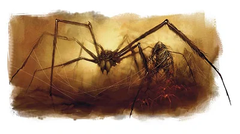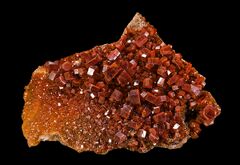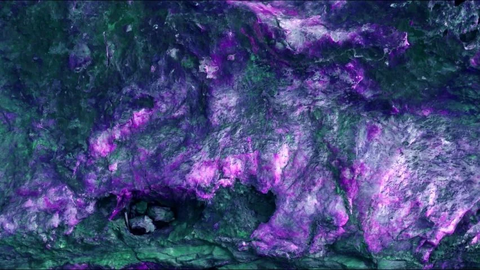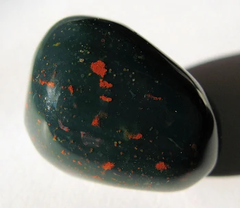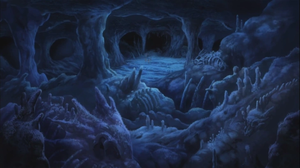Barrows of Mizralgyos
Originally considered to just be an oddity of red plantlife in the south-eastern forestry of Alzhak Reger, one of the lumberyards ended up finding an opening into cave systems below, when trying to uproot a particularly sturdy mangrove tree. Yet another location in the north-eastern section of The Continent of Siacros, further adding to the mystery of the place. Unknown as to what had happened here in the past, it can at least be said now, that the majority of the resources here revolve around blood... very old blood. Likely from some long forgotten conflict, possibly within the homeland of some long dead peoples. Either way, the resources have benefited from this loss, producing quite a bit of metals rarely seen outside of extremely specific ritualistic forging processes. Even the stone itself, has taken on properties, which normally one would not encounter on purpose. After all, who would go to the efforts of permeating blood in stone, rather than the old metaphor of taking blood out of stone?
After having discovered the sheer quantity of draconic remains below, the site was temporarily sealed, with teleportation and magical protections set up, prior to lauching a joint cooperative effort with Starlight Union to preserve what they could for history, while the dwarves made use of the bounty of the earth.
Flora
- Blood Mangroves: Much like their regular cousins, these trees are found on the surface above the barrows themselves, with properties mainly of a mangrove. Taking in nutrients from the ground below, these trees have absorbed quite a bit of red materials over the many years. This has resulted in a rather eerie appearance, from the deposits left on the leaves as part of the mangroves natural processes, likening their appearance with blood. Similarly, when cut, the sap of this tree is known to be dark red, staying so even as it dries, to attempt to seal such cuts in the tree. Although not particularly special, the uniqueness of the material may appeal to some peoples aesthetics more than others.
- Ragweed: Also sometimes called 'bloodweed', it actually is very unrelated to blood. It is a plant with various local medicinal properties, albiet minor ones. The blood part of its name originates from the reddish color obtained when crushing seed heads, and how its sap may stain one's skin. Beyond that, it simply grows on the land above, amongst the mangrove trees.
Fauna
- Tomb spiders: Rather nasty beasts, known for the negative energy within them. Victims can be found coccooned, prior to mummification and later raising as web mummies. Rumored to have made their way upward from somewhere darker, below.
- Web mummies: Victims of tomb spiders, should they manage to pick off larger prey, such as humanoids who wander the area unattended.
Resources
- Chthonic Steel: a somewhat rare metal. It is a mixture of iron, silica, and true dragon's blood, to form a natural red-organ ore amidst veins of crystalline glassed veins of rock, from layered dragon-fire. More brittle in its raw form, what is available here will become far harder upon being forged, the blood integrating itself into the forging process to make golden-red metal with an orange, reflective property when held in the light.
- Dragonsteel: Extraordinarily scarce anywhere, it would appear that this location was particularly blessed in both long-term draconian residency in the past, and high quantities of exposed metal. The result, is that the raw ores were bathed again and again in ancient dragon-fire, as well as passively imbued with the essence of the dragons as they lied nearby, for an unknown length of time. What would have originally been a rich iron mine of extreme purity, it has thus become greater than before, taking on a purplish-blue coloration in its raw form.
- Blood Iron: Unclear as to why, blood mixed from other creatures has also melded its way into the iron within this area, resulting in a lower-quality, but still superior substance to mundane iron. rust-red, and unlike the dragonsteel, even in its most clearly dry state, the metal feels as if it is slick with blood, reeking of the stuff, even if thoroughly cleaned. It is almost as if, even in its ore state, having residual killing intent, from some old battle.
- Bloodstone: Unlike regular stone, this material is flecked thorough with inclusions of blood-like material. Just as with all the metals above... even the rock itself, has whatever once occurred here, seeped into it, resulting in unique properties.
- Bones: Although much of it has been provided to the Starlight Union, bones, mainly those of dragons, can still potentially be found throughout the depths below. Not much in the way of hoards were found, so it is possible this place had been looted once upon a time. That is the theory, at least, by those who discovered it.
Uses by Alzhak Reger
- Bloodstone, although not much better than regular stone as a construction material, the stone itself can be used as a mundane medicinal agent. When a chunk is pressed on an open wound, the blood would immediately coagulate, help close the wound itself, and remove any diseases or poisons in the blood. This does little to help for diseases or poisons elsewhere in or on the blood, however. The chunk is consumed by this action, and is only effective on a given person once a month. No healing truly occurs, as it mainly just causes bleeding to cease. Very useful when broken up, and sent in with supplies to areas experiencing combat, as it would allow many to save their magical reserves, when not needing to be spent on healing what could be taken care of by one such stone.
- Chthonic Steel, much like blood iron and dragonsteel, is mainly made into weapons, armor, or ammunition. However, unlike the other two, it is much more common to see regular items made of the material, due to a different quality, likely from the mixture of glass-like inclusions. Able to hold a supernatural edge, further reinforced by any enhancements on the metal, items made of it, are able to negate magic missiles and other such force-based projections. This can be found to be useful even in thin, but not too thin, layering over defenses. Resulting in an inspiring sight, that may defend against magical bombardments.
- Dragonsteel, when forged into a more refined form, shifts in hue from purplish-blue, to a black metal. Simulanteously lighter and harder than most metals, from the unique situation of the metals origin, it would be a waste to use rashly, given the scarcity. Magical even without enhancement, this metal can easily cut through just about anything, making it the bane of countless hardy foes. Be they demons, aberrations, or a particularly uncooperative and stringy steak. A lesser known use, is in its more crystalline and raw state, where it can be directly inscribed with draconic runes of power, to produce strange and varied effects.
- Blood Iron, when forged into metal products, finds it is difficult to shape it into anything other than tools of war. Be it weapons, armor, or ammunition. Something about the hostility inherent in the material, refuses to be used otherwise. Given the properties, it'd be a waste anyways. Feeling just as slick in refined form, equipment made with such material is used when intimidation is desired, or to increase the deadliness of weapons. This proves especially efficient in weapons already noted to be deadly, such as katanas, Wakizashis, or otherwise. (I would have mentioned others, but its literally like, just those two, in the 1st party equipment options for the Deadly weapon quality)
- Blood Mangroves, mainly used as just regular lumber, they are often sold in various woodcrafts to a subset of folk who enjoy the appearance of such wooden material, even in its full tree form, as exports. Including but not limited to eccentric humans, isolated vampire nobility, or otherwise.
- Bones, mainly used for its historical value than anything else, would be able to be placed within viewable areas for people to see, and learn about.
- Ragweed has leaves that are astringent, emetic, and febrifuge. They can be applied externally to bug bites and other skin irritations. Internally, they can be taken as a tea, to deal with various internal irritations. The juices, may be used as a disinfectant, and its root as yet another common malady easer. As for the pollen itself, when refined, can help deal with allergies of the plant itself.
| Various Setting Locations | |||||||||||||||||||||||||||||||||||||||||||||||||
|---|---|---|---|---|---|---|---|---|---|---|---|---|---|---|---|---|---|---|---|---|---|---|---|---|---|---|---|---|---|---|---|---|---|---|---|---|---|---|---|---|---|---|---|---|---|---|---|---|---|
| This content used to be parts of other sections of the wiki, but was retired/archived due to the relevant player leaving the server, that version of a location no longer being in-use but kept for historical record, or had mechanics that were no longer legal to use, despite being canonical. This navigation only displays categories that has archived pages in them, and only tries to organize them briefly, it is by no means an indicator of limits of what is archive-able. Some may also be archived in preparation to a later re-write for more current lore. | |||||||||||||||||||||||||||||||||||||||||||||||||
| Geographical Locations | |||||||||||||||||||||||||||||||||||||||||||||||||
| Planes |
| ||||||||||||||||||||||||||||||||||||||||||||||||
| Heavenly Bodies | |||||||||||||||||||||||||||||||||||||||||||||||||
| Continents (Currently only includes Chronus, but is not limited to one planet) |
| ||||||||||||||||||||||||||||||||||||||||||||||||
| Cities | |||||||||||||||||||||||||||||||||||||||||||||||||
| Nations | |||||||||||||||||||||||||||||||||||||||||||||||||
| The Towers of Magic (only sub-pages are listed below, more information on the main tower page) | |||||||||||||||||||||||||||||||||||||||||||||||||



